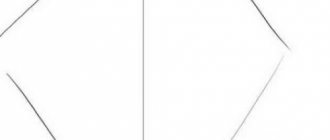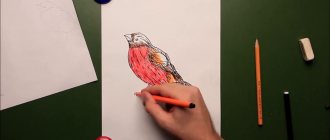Notes on drawing in the middle group “Teddy Bear”
Goal : to make children want to draw a bear using a stencil (outline), learn to paint along the contour using the “poke” method, consolidate knowledge of color (brown), and instill interest in drawing in different ways.
Materials: a sample of a finished drawing of a bear, an outline of a bear on a landscape sheet, a toy - a large brown bear, stencils, bristle brushes No. 4, thin soft brushes, a simple pencil, gouache (brown, black), napkins.
Progress of the lesson:
1. Organizational moment, problematic situation.
- Guys, it seems like someone is crying, can you hear it in the doll corner?
-Who is crying here? (Bear). Yes, this is Mishka the clubfooted one.
- How did you end up here, Mishka, and why are you crying? (The teacher voices the toy.)
- I came to you from the forest. Winter will come soon and I need to go to bed in the den.
“And why did this upset you so much?” After all, all bears sleep in their dens in winter. They feel warm and cozy there in winter.
- Yes it is. I already wanted to lie down in my den for the whole winter, but I remembered that I have no friends, I am so alone. And I felt very, very sad (crying).
- Don't cry, Mishka! You are so beautiful, fluffy, shaggy, calm down (Bear is crying).
- Oh, guys, what should we do? How can we cheer up Mishka? We need to help him find friends. But how? (Children's answers.)
- Can you draw it?
- Calm down, Mishka, don’t be sad, we will help you find friends as beautiful as you.
- Let's go to the tables (everything you need is there).
I have a friend in my hands for our Teddy Bear (show a sample and turn to the toy).
- Look, Mishka, you will have many such beautiful and kind friends.
2. Main part.
— Today we will draw a bear using a stencil. You have stencils of bears on your tables, they are all different: some have a bear standing, some have a bear dancing, some have a bear doing exercises. We will draw different friends for Mishka. To do this, you need to put the stencil on a sheet of paper and trace along the outline with a pencil.
- First, take the stencil in your hand and trace it with your finger. Like this. And then we will color the Bear, and we will do it in a new way. To depict the bear as fluffy, we will use a bristle brush. The brush will work in a special way: it will jump up and down. Take the brushes in your hands and try them without paint (show how the brush will work).
- Well done, you are doing everything right! We start coloring from the head. Look, I'm picking up paint. What color paint do we need to paint the bear? (Brown.)
— I pick up some brown paint and start drawing along the contour. I will go around the entire outline using the “poke” method, then I will paint over the entire bear using the same method. My brush is jumping up and down. The result was a beautiful, fluffy bear. But what did I forget to draw? (Eyes, mouth, nose.) To draw the eyes, mouth, nose, I will take a thin brush, dip it in black paint and paint with the end of the brush. What is my bear's mood?
3. Physical education minute: “Two bears were sitting…”
4. Independent activity of children.
- And now you will each draw your own bear. What kind of bears will you have - happy or sad?
5. Summing up.
Analysis: (I take a toy) Bear, look how many friends you have now! The kids tried so hard to help you. Now you can sleep peacefully in your den.
- Thank you, guys, I like this funny little bear, and this funny one, and I really like them all and now I have a lot of friends! Hooray! Goodbye!
- But before you leave, play with us (the game “Bear-toed Bear”).
- Thank you for staying with us to play. And now it's time for you to go into the forest, goodbye.
description of where they live, what they eat, habitat
Polar bears are considered predatory animals, but they are fairly close relatives of brown bears.
This mammal represents the largest land predator that is found on our planet within the polar latitudes.
Polar bear: description
This animal is the largest in its class, since adult individuals can grow up to 3 meters in length, while its weight can reach 1 ton. The average size of the predator is within 2.5 meters, with a maximum weight of about 800 kg. The height at the withers of adult individuals reaches almost one and a half meters.
Females are significantly smaller in size and weight; their weight rarely reaches 250 kilograms. The smallest bears are found in the Spitsbergen archipelago, and the largest polar bears inhabit the Bering Sea basin.
Interesting to know! It is difficult to confuse a polar bear with any other animal, since it has characteristic differences: pure white fur, a long (comparatively) neck and a flat head. The color of the coat, depending on the time of year, can vary from pure white to a yellowish tint. As a rule, the fur turns yellow in the summer as a result of exposure to sunlight.
The fur of polar bears does not have pigment for coloring, and the hairs themselves have a hollow structure. Due to this structure of the hairs, they can only transmit ultraviolet radiation, which contributes to the high thermal insulation qualities of the animal’s coat. Hair also grows on the soles of its paws, which allows the bear to confidently move on slippery ice. Between the toes there are membranes, thanks to which the polar bear feels great in the water. The predator's claws are large and powerful, so the polar bear is able to cope with very large prey.
Extinct subspecies
At one time, there was another subspecies of the polar bear, which was a close relative of the modern polar bear and which was distinguished by its gigantic size. The length of adult individuals reached 4 meters, and their weight was more than a ton.
It was possible to learn about similar characteristics of an extinct species thanks to the discovered remains. They were discovered in England, in Pleistocene deposits. It was possible to discover the ulna of the beast and, as it later turned out, it belonged to a giant polar bear. Based on its characteristics, this predator was perfectly adapted for hunting the same large mammals. Why did they die out? Yes, because there was not enough food for everyone, and especially for large predators, which require a lot of food for their livelihoods. At least that's what experts think.
Habitat
The natural habitats of the polar bear extend to the northern coasts of the continents, as well as to the southern parts of drifting ice floes bordering the warm currents of the seas and oceans. The habitat of these animals includes 4 zones:
- Places of permanent residence.
- Animal habitats.
- Locations of pregnant females.
- Territories located to the south where polar bears reach.
Polar bears are found along the entire coast of the Arctic Ocean, with the most numerous populations located on the continental slope of the ocean.
As a rule, pregnant females lie:
- In the northwest and northeast of Greenland.
- In the northern part of Spitsbergen.
- On the territory of the northern part of the island of Novaya Zemlya.
- On the territory of the western part of Franz Josef Land.
- On the small islands of the Kara Sea.
- Within Severnaya Zemlya.
- On the Taimyr Peninsula, or rather on its northern and northeastern coasts.
- On the bear islands of Eastern Siberia and in the Lena delta.
- On the coasts and adjacent islands of the Chukotka Peninsula.
- On Wrangel Island.
- On Banks Island, or rather on its southern part.
- On the coasts of the Simpson Peninsula.
- On the northeastern coast of Baffin Island, as well as on Southampton Island.
Deposits of female polar bears have even been observed on pack ice floes in the Beaufort Sea. In early spring, polar bears migrate from time to time, appearing in Iceland and Scandinavia, in the Gulf of Anadyr, Kamchatka, and also on the Kanin Peninsula. They often reach the Sea of Okhotsk and the Sea of Japan.
INTERESTING FACT - POLAR BEAR. THE BIGGEST PREDATOR ON EARTH
Watch this video on YouTube
What does it eat?
This large predator has an excellent sense of smell, hearing and vision, so it is able to detect its potential prey several kilometers away.
The diet of a polar bear depends on the characteristics of its habitat, as well as the capabilities of the animal’s body. This animal is adapted to life in such harsh conditions of the polar winter. It feels great in the cold water of the Arctic Circle, so the basis of its diet is made up of marine inhabitants of the same cold latitudes. In addition to mammals, polar bears do not refuse fish, eggs, chicks, young animals, as well as carrion of any origin if the corpses of fish or animals are washed ashore by a wave.
Under certain conditions, polar bears' feeding can be selective, and in some cases they eat the corpses of their fellows.
Sometimes they dilute their diet with various berries and moss. Climatic conditions have recently changed not in favor of bears and other animals, so lately these animals are increasingly hunting on land.
Lifestyle
Polar bears make seasonal migrations due to the process of changing the territories and boundaries of northern ice, depending on the time of year. Therefore, in the summer, animals approach the North Pole, and in the winter, on the contrary, they return and often even go to the mainland.
Interesting to know! In winter, polar bears lie down in dens, which are located on the mainland or on islands. As a rule, dens are located no further than 50 meters from the water line. As it is, they mostly stick to the coasts or are on the ice.
A polar bear can sleep for about 2 or 3 months, although it is mainly females who hibernate, and especially pregnant ones. Males and young animals, although they hibernate, do so for a very short period and this process is not regular.
The polar bear feels great both in water and on land.
The first thing that catches your eye is the apparent slowness and clumsiness when the bear moves on land. In fact, this is not so; on land he is as agile and fast as in water. Therefore, you should not count on being able to escape from a polar bear, if anything. The polar bear's body is covered with a waterproof fur coat, which perfectly retains heat. In addition, this animal has a subcutaneous fat layer thickness of about 10 cm, which allows the bear to feel comfortable in extreme conditions. Since the main coat color of the mammal is white, the animal is practically invisible against the background of snow cover and ice.
Reproduction process
Nature has allocated a whole month of time for the reproduction process in polar bears. The breeding process begins somewhere in mid-March. During this period, you can see not solitary males, but animals distributed in pairs, although there are cases when several males are located next to the female.
The mating period lasts about a couple of weeks.
Polar bear pregnancy
A fertilized female carries her future offspring for an average of 8 months. In the initial stages of pregnancy, it is unlikely that a fertilized female can be distinguished from an unfertilized one, but two months before giving birth, the fertilized female becomes irritable, inactive and often lies on her stomach. During this period, the female loses her appetite. As a rule, two cubs are born, but primiparous females, as a rule, give birth to one cub. A pregnant bear spends the entire winter in a den, which is located as close as possible to the sea coast.
The appearance of cubs
After birth, the cubs are not yet able to warm themselves, so the bear lies curled up on her side. The cubs are between her paws and chest, and she also warms them with the warmth of her breath. The cubs that are born weigh no more than a kilogram, and their length is within 25 cm.
As a rule, newborn cubs are blind and only after a month and a half do they begin to see. Already at the age of one month, the female bear feeds her offspring in a sitting position. In March, females leave their shelters en masse. During the same period, bear cubs emerge from the den from time to time to take a walk during the day with their mother. They return to their lair for the night. The cubs play and bathe in the snow.
Interesting fact! Typically, up to 30 percent of bear cubs and up to 15 percent of young, immature individuals die, which has a significant impact on the polar bear population.
Natural enemies
Such a large predator as the polar bear has practically no natural enemies, although killer whales and polar sharks pose some danger. Mostly, adult individuals die as a result of injuries received as a result of skirmishes among themselves or when hunting large walruses, which can easily pierce the body of a bear with their tusks.
No less often, polar bears die from starvation.
Humans are considered the most dangerous enemy of polar bears, especially since such northern peoples as the Eskimos, Chukchi, and Nenets have hunted this animal for many centuries and continue to do so to this day. Human economic activity has an equally detrimental effect on the number of polar bears. In one season, hunters killed at least a hundred polar bears. A little more than half a century ago, polar bear hunting was banned, and in 1965 it was included in the list of endangered species.
Danger to humans
There are known cases of this predator attacking a person, although it is all the fault of the person himself, who is introduced into the living space of these animals. As a rule, this is mentioned in the notes or reports, if you can call them that, of polar travelers. Therefore, in places where this predator may appear, you need to move with great caution. It is necessary to take all measures to ensure that conditions are created in human habitats that would not attract hungry animals.
Finally
The polar bear is considered not only the largest predator, but also a beautiful, noble animal. According to scientists, today there are a little more than 30 thousand such animals in the world, but this is according to the most optimistic forecasts. By 2050, the number of these animals may be reduced by a third. The number of livestock is significantly influenced by:
- Poaching . Despite existing prohibitions and a number of security measures, poaching continues to do its dirty work. And all because the prices for polar bear skins (especially on the black market) are simply fabulous. Therefore, some poachers are not stopped by the measures and laws that are aimed at preserving this animal for our descendants.
- Global warming. According to scientists based on research, the Arctic ice cover is melting more and more every day. According to American scientists, in the next decade the area of Arctic ice, which is the natural habitat of polar bears, may decrease by almost 40 percent.
It is believed that at the moment this figure is at least 25 percent, although many scientists believe that these are purely optimistic figures. - Environmental pollution . This process is also global in nature and extends to marine areas and coastal zones of the Arctic. This can include pollution with pesticides, radionuclides, fuel combustion products, pollution with heavy metals, fuels and lubricants, oil, etc. In other words, pollution of the surrounding Arctic space is associated with human activity. Considering that the polar bear is a long-lived predator, its body experiences the negative effects of many toxic components over many years.
If you delve into the positions, it becomes obvious: man is thoughtlessly invading nature, exerting an exclusively negative influence on it, from which the animal world suffers. For some reason, a person does not think about the fact that he is next in line. Mindlessly killing nature, he kills himself.
Super Predators - Polar Bear (Documentaries, HD broadcasts)
Watch this video on YouTube








